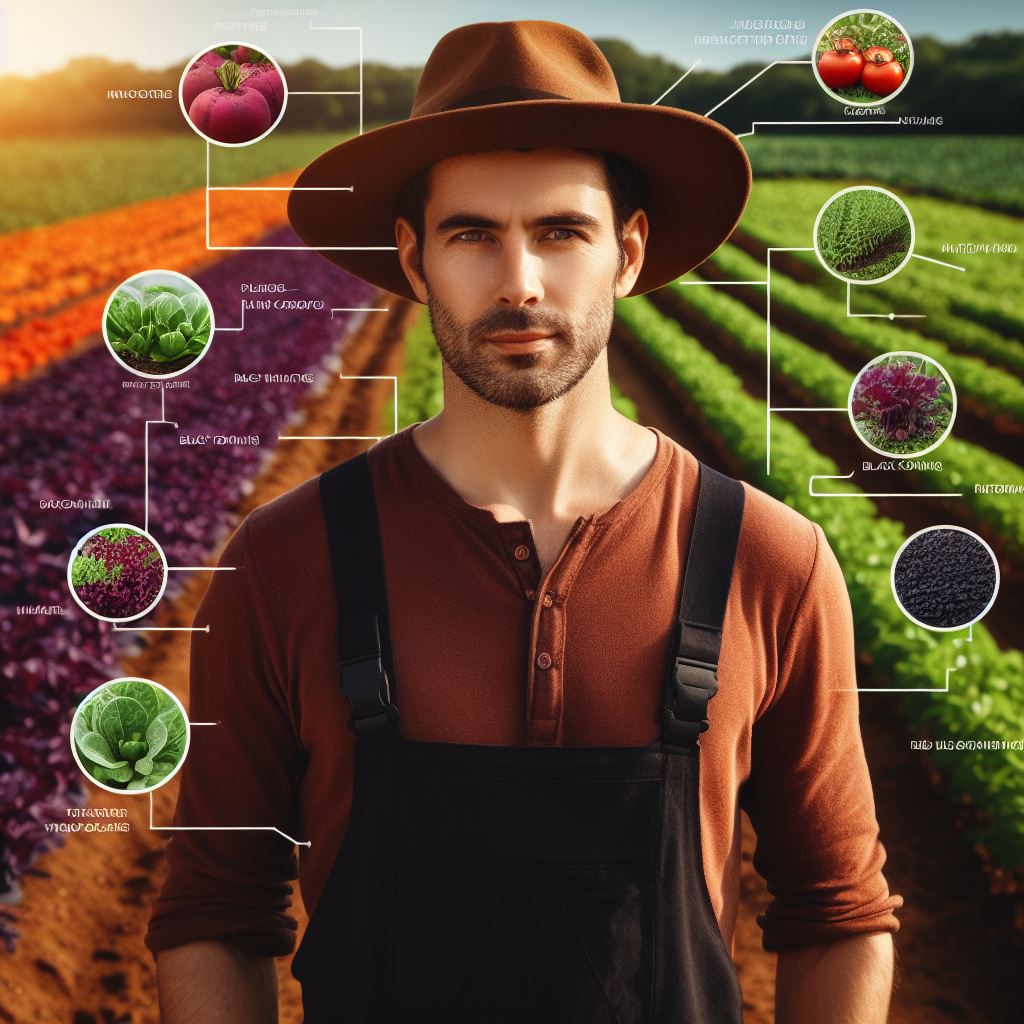Innovative Crops: Beating Climate Heat & Drought
Last Updated on March 2, 2024
Introduction
Innovative crops play a crucial role in combatting the challenges of climate heat and drought.
These crops are essential for sustaining agricultural productivity and ensuring food security.
Transitioning to discuss the various innovative crops that can address these issues effectively.
Explanation of the importance of innovative crops in combating climate heat and drought
- Drought-tolerant varieties, such as genetically modified maize, offer resilience in water-deficient conditions.
- Climate-smart rice, bred to withstand higher temperatures, helps secure staple food production.
- Root crops like cassava have shown promises in adapting to extreme temperatures and irregular rainfall patterns.
- Legumes, such as chickpeas and lentils, possess a unique ability to fix nitrogen, enhancing soil fertility.
- Agave plants are gaining attention due to their ability to thrive in arid environments and produce biofuel.
- Farmers are exploring the potential of ancient grains like quinoa, which are naturally resistant to drought and heat stress.
- Hydroponic systems enable the cultivation of high-value crops in controlled environments, minimizing water usage.
- Vertical farming, using tall structures and LED lights, maximizes space efficiency and reduces water consumption.
- Aquaponics, a symbiotic system between fish and plants, allows year-round cultivation in water-saving setups.
- Cover crops, like clover or rye, prevent soil erosion, retain moisture, and improve soil health by increasing organic matter.
These innovative crops provide hope for overcoming the challenges of climate heat and drought.
By diversifying agricultural practices and implementing these solutions, farmers can ensure sustainable food production even in the face of a changing climate.
Drought-Tolerant Varieties
Overview of the concept of drought-tolerant crops
Drought-tolerant crops are plant varieties that have been bred or genetically modified to withstand extended periods of dry weather.
Description of specific drought-tolerant crops (e.g., millet, sorghum)
Millet
Millet is a small-seeded cereal grain that can thrive in arid conditions with minimal water requirements.
It can be utilized as food for humans or livestock feed.
Sorghum
Sorghum is a versatile crop with excellent drought tolerance.
It can be used for food, animal feed, and even produce biofuels. Its resilience makes it an ideal crop for regions prone to droughts and limited water availability.
Examples of successful implementation and benefits
Sub-Saharan Africa
In countries like Mali and Burkina Faso, the introduction of drought-tolerant varieties has significantly increased crop yields and food security, helping farmers adapt to climate change.
Australian Outback
In regions facing extreme heat and dry conditions, farmers have successfully integrated drought-tolerant crops such as sorghum into their agricultural practices, ensuring sustainable crop production.
Challenges faced in cultivating drought-tolerant crops
Genetic modification controversies
The use of genetically modified drought-tolerant crops raises concerns among consumers and environmentalists, leading to debates about their safety and long-term impacts.
Limited access to drought-tolerant seeds
Small-scale farmers in developing countries often struggle to access and afford drought-tolerant seeds, hindering their ability to adopt these technologies and cope with droughts.
Adaptation to local conditions
Drought-tolerant crops may not perform uniformly across all regions, as their effectiveness depends on various factors like soil type, climate, and availability of other resources.
Summary on the potential of drought-tolerant varieties
Drought-tolerant crops have shown immense potential in mitigating the negative impacts of climate change, particularly in regions prone to heatwaves and water scarcity.
However, it is crucial to address challenges such as ensuring equitable distribution and the proper assessment of their long-term effects.
Read: Climate Change: A Real Threat to Global Farming
Heat-Resistant Crops
Introduction to the concept of heat-resistant crops
Heat-resistant crops are plants that can withstand high temperatures and thrive in extreme weather conditions.
Description of specific heat-resistant crops (e.g., cowpea, okra)
Cowpea, also known as black-eyed pea, is a heat-resistant crop commonly grown in Africa and Asia.
It has developed mechanisms to tolerate extreme temperatures and drought. Okra, another heat-tolerant crop, is popular in tropical regions like India, where it is commonly used in culinary dishes.
Examples of how heat-resistant crops have thrived in challenging climates
Cowpea has been successfully cultivated in regions with high temperatures, such as sub-Saharan Africa, where it serves as a staple food source.
Okra has demonstrated resilience in arid climates, with its deep root system enabling it to access water in dry soils.
Importance of heat-resistant crops in ensuring food security
Heat-resistant crops play a vital role in ensuring food security, especially in regions prone to hot and dry climates.
These crops can withstand the impact of climate change, reducing vulnerability to crop failures and ensuring a stable food supply.
The significance of heat-resistant crops
Heat-resistant crops offer a promising solution to the challenges posed by climate change.
By cultivating and promoting these crops, we can enhance food security and adapt to the increasing heat and drought conditions faced by farmers worldwide.
Read: Rising Temps: How Crops Struggle and Adapt

Novel Approaches to Crop Modification
Explanation of genetic modification techniques for improving crop resilience
- Genetic modification involves altering an organism’s DNA to enhance specific traits.
- To improve crop resilience to climate challenges, scientists modify genes related to stress tolerance.
- Techniques like gene editing, RNA interference, and genetic engineering are employed to achieve these modifications.
- Gene editing enables precise changes to be made in the DNA sequence, providing a powerful tool in crop improvement.
- RNA interference regulates gene expression, offering potential for enhancing drought and heat tolerance in crops.
- Genetic engineering involves inserting genes from other organisms to confer desired traits in plants.
Discussion of cutting-edge research and innovations in crop modification
- Scientists are harnessing advances in biotechnology to create crops resistant to extreme climate conditions.
- One approach is developing crops with improved photosynthesis efficiency to enhance productivity in heat and drought.
- Researchers are exploring the use of nanoparticles to deliver genetic material to plants, aiding in crop modification.
- Innovation in molecular breeding techniques has facilitated the rapid development of stress-tolerant crop varieties.
- Techniques like marker-assisted breeding and genomic selection allow precise selection of desirable traits in plants.
- Genetic modification has also been used to enhance nutritional content, improving food security and human health.
Benefits and potential risks associated with novel crop modification techniques
- Novel crop modification techniques offer numerous benefits, including increased crop yields and enhanced stress tolerance.
- By improving crop resilience, these techniques contribute to sustainable agriculture and food security.
- Enhanced resistance to pests and diseases can be achieved through genetic modification, reducing the need for pesticides.
- However, potential risks associated with genetically modified crops require careful consideration.
- Environmental concerns include gene flow to wild relatives, potentially affecting biodiversity.
- Human health risks, such as allergenicity and unknown long-term effects, necessitate rigorous safety assessments.
Regulation and public perception of genetically modified crops
- Regulation of genetically modified crops varies globally, with some countries adopting strict policies while others are more permissive.
- Regulatory frameworks aim to ensure the safety of genetically modified crops for both human and environmental health.
- Public perception of genetically modified crops varies, with concerns about safety and ethical implications being common.
- Transparent communication between scientists, regulators, and the public is crucial to address fears and build trust.
- Educating the public about the scientific evidence and benefits can help improve acceptance of genetically modified crops.
Overall assessment of the role of novel crop modification in tackling climate challenges
- Novel crop modification techniques have the potential to play a significant role in addressing climate challenges.
- By improving crop resilience to heat and drought, these techniques can enhance food production in changing climates.
- Increased crop productivity can reduce the pressure on natural ecosystems, promoting sustainable agriculture.
- Collaborative efforts among scientists, policymakers, and farmers are essential to maximize the benefits of novel crop modification.
- However, strict regulation, ethical considerations, and public acceptance are crucial for responsible deployment of these techniques.
- 6. Balancing scientific advancements with environmental and societal concerns will be key in harnessing the full potential of crop modification.
Read: Rising Temps: How Crops Struggle and Adapt
Integrating Innovative Crops into Sustainable Farming Practices
Importance of agroecological approaches for successful implementation of innovative crops
- Agroecological approaches prioritize sustainable farming practices and the integration of innovative crops.
- These approaches consider the ecological interactions between crops, soil, water, and biodiversity.
- By utilizing agroecological principles, farmers can enhance the resilience and productivity of their fields.
- Proper management of soil health, pest control, and nutrient cycles are central to agroecology.
- Agroecology minimizes the use of synthetic inputs, reducing environmental and health impacts.
- Through agroecology, farmers can improve the long-term sustainability of their agricultural systems.
Discussing sustainable farming techniques that support innovative crops (e.g., conservation agriculture)
- Conservation agriculture is a set of practices that minimizes soil disturbance, maintains soil cover, and enhances crop diversity.
- Conservation agriculture helps reduce soil erosion, enhances water retention, and improves soil fertility.
- This farming technique involves minimum tillage or no-till practices to protect soil structure and prevent erosion.
- Maintaining crop residue on the soil surface helps conserve moisture, suppress weeds, and improve organic matter content.
- Precision agriculture technologies can be integrated with conservation agriculture to optimize input use and reduce waste.
- Sustainable use of organic fertilizers and organic pest management are important components of conservation agriculture.
Benefits of crop diversity and intercropping in mitigating climate risks
- Crop diversity and intercropping create resilient farming systems that can better withstand climate change impacts.
- Growing a variety of crop species ensures a buffer against unpredictable climate events, such as drought or extreme heat.
- Different crops have varying responses to climate stress, reducing the overall vulnerability of the farming system.
- Intercropping, or growing multiple crops together, promotes beneficial interactions between species and enhances ecosystem services.
- Nitrogen-fixing legumes in intercropping systems improve soil fertility and reduce the need for synthetic fertilizers.
- Crop diversity and intercropping also enhance biodiversity, providing habitats for beneficial insects and natural pest control.
Collaboration between farmers, scientists, and policymakers to promote sustainable farming practices
- Effective collaboration among farmers, scientists, and policymakers is essential for the adoption of sustainable farming practices.
- Farmers’ knowledge and experiences can inform scientific research and policymaking processes.
- Scientists can provide evidence-based information and innovative solutions to address farming challenges.
- Policymakers play a crucial role in creating supportive agricultural policies that incentivize the adoption of sustainable practices.
- Collaborative platforms, such as agricultural extension services, farmer networks, and research institutes, facilitate knowledge exchange.
- Joint efforts among these stakeholders can lead to the development and implementation of effective sustainable farming policies.
Highlighting the role of sustainable practices in maximizing the potential of innovative crops
- Incorporating innovative crops into sustainable farming practices is essential for achieving food security and climate resilience.
- Agroecological approaches, conservation agriculture, and crop diversity contribute to sustainable farming systems.
- By prioritizing sustainability, farmers can optimize the performance and benefits of innovative crops.
- Collaboration between farmers, scientists, and policymakers is crucial for successful implementation.
- Sustainable farming practices maximize the potential of innovative crops to combat climate heat and drought.
- The integration of innovative crops into sustainable farming practices is a vital step towards building a resilient and productive agricultural future.
Read: Climate Change: A Real Threat to Global Farming
Gain More Insights: Navigating Climate Policy: US Farmers’ Guide
Explore Further: Climate-Smart Farming: The Diversity Strategy
Conclusion
Recap of the main points discussed in the blog post
In this blog post, we explored the importance of innovative crops in tackling the challenges of climate heat and drought.
We discussed various examples of these crops, including drought-tolerant varieties and heat-resistant crops, that are being developed to thrive in challenging climatic conditions.
These innovative crops not only offer a solution to food security concerns but also have the potential to mitigate the impacts of climate change on agriculture.
Final thoughts on the significance of innovative crops in addressing climate heat and drought challenges
The significance of innovative crops cannot be overstated.
With rising temperatures and increased frequency of droughts, traditional crops face severe challenges.
Innovative crops provide an opportunity to adapt and ensure food production in a changing climate.
By developing new varieties and adopting advanced technologies, we can enhance crop resilience, increase yields, and mitigate the risks posed by climate heat and drought.
Call to action for farmers, researchers, and policymakers to prioritize the development and adoption of innovative crops for a sustainable and resilient future
It is crucial for farmers, researchers, and policymakers to prioritize the development and adoption of innovative crops.
By investing in research and development, promoting sustainable farming practices, and providing support for farmers to access these crops, we can build a more resilient agricultural system.
Policymakers must create an enabling environment that incentivizes the adoption of innovative crops while also considering the concerns of small-scale farmers.
Collaboration between stakeholders is vital to ensure the successful development and implementation of innovative crops for a sustainable and resilient future.


